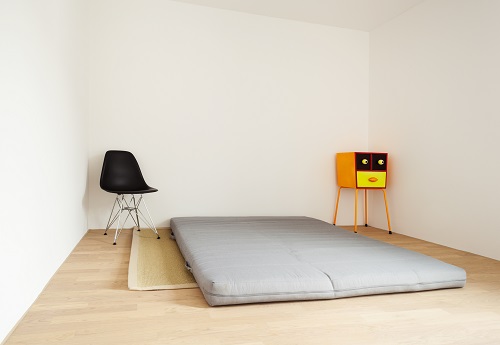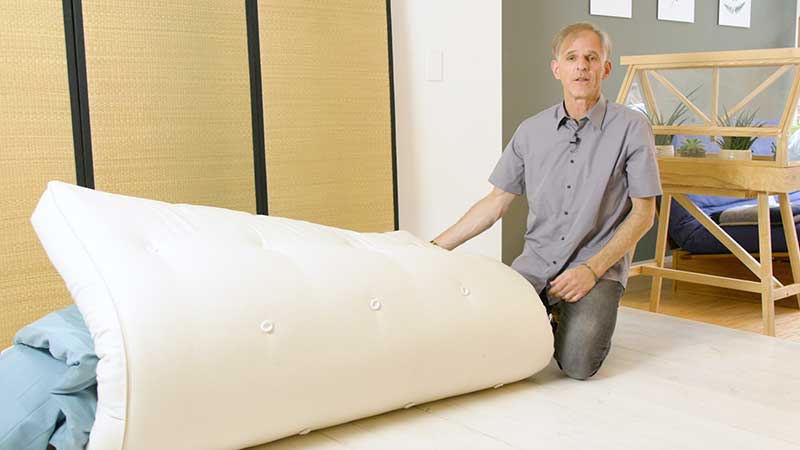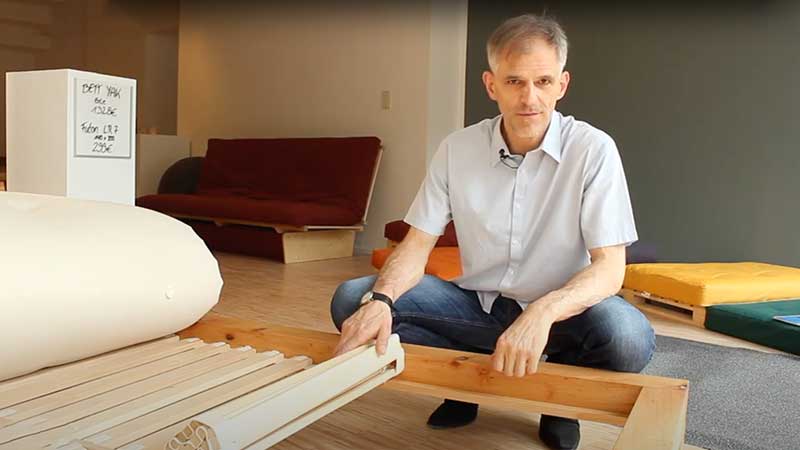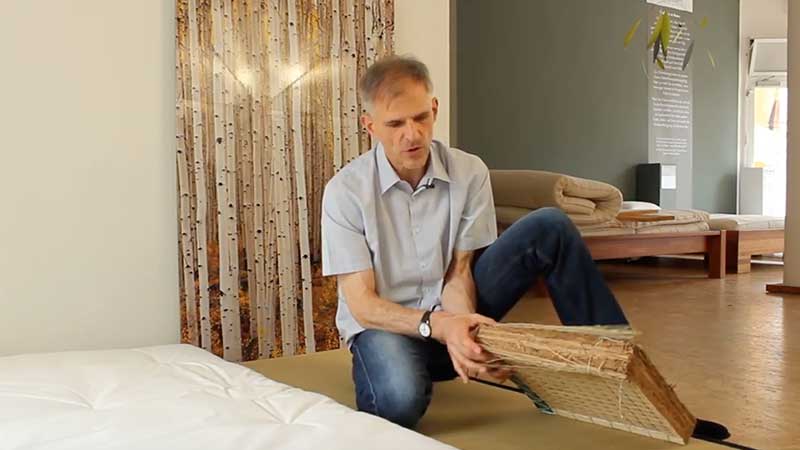Utilization tips for your futon and tatami
Futon Utilization Tips
Your new FUTON is a top-quality product of exquisite, natural raw materials and carefully manufactured by hand. Here are our tips on how to maintain the nice quality as long as possible:
The laying-in phase
Your futon has a high proportion of fine natural fibers, which are fragile and deformable. If a fold/bulge occurs during transport, you can best flatten them by evenly smoothing them with a flat hand.
It could also be that your futon does not yet have the nominal dimensions, but is 1 to 2cm shorter / narrower and therefore thicker. This is due to the inflated fibers and regulates itself after a few days (depending on the type). Our futons are generally very stable. Pits occuring during the laying-in phase are normal and vary in intensity, depending on the type of futon, body weight and base.
Once the laying-in phase is over and the futon has reached its final form, these deformations, which are primarily of visual nature only and therefore don't affect your sleep, disappear. The length of the laying-in phase depends on the ratio of the futon size and your body weight; a small futon with a tall / heavy sleeper is laid-in after a few weeks, a big futon with a light person can take up to two years to be laid-in. After this phase, the futon won't change anymore aside of becoming slightly flatter over the years.
The more you turn and rotate your futon during the laying-in phase, the better and the more even it will be; every 14 days / with every change of bedding would be a good choice. Once the pits/deformations on the surface have been "laid out", meaning the final form has been reached, turning/rotating the futon every quarter of the year is sufficient.
How do I ventilate my futon?
For a bed with slatted or roll-up frame, that is standing with its head-end against an inner wall of a higher floor, there is no need to air out a futon regularly. It is enough to leave the bed with the blanket folded on the foot-end during the day and to turn/rotate the futon once or twice every quarter year so that it gets evenly stressed.
If a futon lies on the floor it needs somewhat more attention in terms of air-circulation, so that humidity, that condenses due to the heat differance of top and bottom, can escape. If it lies on a carpet, or even better a natural fiber carpet it is enough to turn the futon once or twice a month, because the carpet functions like a mattress protector.
If the futon lies on flat, hard floor (like parquet, tiles, vinyl, laminate,..) and humidity can not escape, then one should fold half of the futon onto the other half to dry once a week. Swap which half of the futon gets fold over each time. During Winter it is importent do this consistently. Same on the ground floor or souterrain. Should the futon lie close to a cold outer wall one should pay more attention, than when it lies in the center of the room.
Which cover should I use?
The washable slipcover (bio Deluxe) is a little abundantly applied because the fabric - especially for large dimensions – will shrink during washing. The satin fabric is elastic and dimensionally stable and always finds its perfect fit.
You can wash the washable slipcover at 60°C (if possible without or only shortly using a dryer - 3 minutes) and dry on a clothes line. Afterwards put it on while it's slightly moist and keep it uncovered to dry fully.
Washing at 30-40°C for delicate material is gentle on the fabric and makes it remain supple for longer.
Of course, our regular slipcovers can be washed as well, but only cold, up to 30°C. You can also re-order protective covers from us at anytime, with the perfect fit for your futon. If your futon cover has stains, simply wipe them out with a damp cloth and soap and blow dry the wet spot. Please do not remove the original with buttons linked cover. Removing it is not intended and, in addition to the insane work it takes, there is no guarantee that the futon will return to its original look afterwards.
Buttons and handles on the futon
If by heavy wear / frequent transporting a button tears, i.e. disappears in the cover, this does not affect the function of your futon. The buttons and splint tapes essentially have a temporary function which becomes irrelevant for the most part after the laying-in phase is over.
Some users of futons with slipcover (for example Deluxe) cut off the buttons / splint tapes.
Individual buttons / splint tapes can obtained through us for free at any time. We also lend the tool needed to put on buttons / split tapes, although that's rare.
If you have a futon with turning handles, please consider the ratio of the fine cloth of which the handles are made, to the high total weight of the futon - especially for sizes of 160/200 and bigger. Although the handles are sewn in carefully and secured, they are made for the sole purpose of lifting and turning the futon. Violent tearing or wearing should be avoided to prevent damage to your futon.
Turning / Venting - Care instructions
Note: Each mattress wants to be turned on a regular basis and rewards that by extending the span of its useful life. The rumor that futons allegedly require a special amount of care strives from the fact that manufacturers of conventional mattresses don't speak of care. In general, the following is true: Good and well cared for mattresses last longer than cheap and uncared for mattresses. Who would have thought?
Regular turning relieves the material and leads to a slower and more even wear; it would be great with each change of linen, but quarterly is sufficient for a long life. Turn the futon both the longitudinal and transverse axis to obtain a uniform result. The rolling or shaking usually done in very thin, simply cotton futons in order for them to last a few years are neither possible nor necessary with most of our futons.
A summer sun bath also increases the life of your futon; the higher the cotton content, the more significant - so if you get the chance, you should take it. You will be surprised how the sun straightens the fibers again, especially the cotton. The reason for that is simply the effect of the UV radiation on bacteria which grow in the moisty and warm enviroment of mattresses.
Fresh air in the form of good ventilation is a daily requirement and usually regulates the regeneration and refreshing of a mattress. Since your futon absorbs a lot of moisture for the benefit of your sleep climate, it requires the opportunity during the day to emit this again. Furthermore the hygiene effect of wool regenerates using oxygen.
The ideal base

Your futon is best rested on an as uniform area as possible, so on the floor. If that's not to your liking, put Tatami underneath the futon; while it doesn't contribute to the ventilation, it offers a pretty sleeping place. For most people who are used to sleeping in beds we recommend the use of a roll-up frame / frame of solid wood (space between bars < 4cm), which is simple and fair priced while being effective.
Those who want or need to increase the comfort of their futon noticably should put their futon on an elastic base ergoVlex frame, which adjusts to the form of your body in side position and decreases pressure considerably. You can put each of our futons on each of those bases.
Durability of the futons
The lifespan of a product can hardly be named accurately - especially not in regards to a mattress due to the fact that factors such as the amount of use and the climate it is used in vary too much. Once you have found the right futon for yourself, it will offer you good comfort for 12-15 years due to its high material and manufacturing quality, assuming it is well taken care of and ventilated.
That we promise you.
Tatami Utilization Tips
Tatami are floor mats after the old Japanese model of
compressed rice straw and a surface of fine Igusa-grass.
Aside our Tatami Info-page we have some additional notes for you here:
General Handling of Tatami-mats
Tatami are initially greenish, over time the color changes more to yellow-brownish. Tatami are made of straw and therefore do not tolerate moisture well. Upon contact with water the strong smell of wet straw will occur. The wet straw also encourages growth of mold*. Make sure to protect your tatami from moisture and dry it if necessary!
We offer the so-called High Quality Tatami (HQ), 5.5 cm. These are extremely condensed / compressed and correspondingly heavy and sturdy. The weight is 14 kg / sqm.
Your Tatami will be delivered securely packed in cardboard. Due to the long travelling time in this package, without air, the smell will have gathered and the tatami requires a few days, preferably in a separate room at room temperature to air out. The tatami essentially offers neither comfort nor ventilation properties, meaning they neither improve the laying quality nor contribute to the ventilation of your futon. They much rather serve as an optical demarcation of the sleeping place and to protect the futon from dust / dirt.
* We have had all tatami that are common in Germany tested, from 'Bale' to 'Karup', and noticed that a certain potential for mold generally exists. This is usually not a problem for adults and is not hazardous to health, but can - when used in 'wrong rooms'** - spread, for example over to your futon.
** We advise against using tatami if you live on the ground floor, in the basement, in badly ventilated rooms or with two walls to the outside, i.e. locations with a lot of condensation. Flats on higher floors or with underfloor heating are better suited, along with placing the tatami within the room rather than in a corner.
Tatami and Futon in harmony
First of all, Tatami do not improve comfort of your futon, nor do they help with air air-circulation. They mostly serve as visual seperation of the sleeping area and to protect the futon from dust and grime.
If you put a tatami-mat in a tatami bed, make sure that the surface of tatami and the bed frame is as flat as possible. Should the tatami lie deep in the bed frame your futon does not get enough ventilation.
Please ensure good ventilation (especially during the winter) of your futon, due to the significant heat difference between the futon top and bottom, especially in cool bedrooms condensation moisture forms, which can lead to stock mold growth. You can avoid this by folding your futon regularly, head to foot and vice versa, so the condensation moisture can dry.
In the acute season or more humid areas this should occur at least weekly, in dry situations accordingly less. Slight stock mold is not harmful and can be removed with soap; then dry with a hair dryer.
Purity (notes for people with allergies)
Tatami are trading goods for us, thus are not subject to our criteria for material purity. They are all from China and Indonesia (never from Japan! *). There is little information to be obtained concerning purity on the part of the suppliers and importers. What we can say is that there is no reason to treat tatami with chemicals and it is probably not done accordingly, and that they are individually packed in strong cardboard, so there is no contamination to be expected from the outside in the container.
* Of course you can get Japanese tatami, but - to our knowledge - not in Germany / outside of Japan, and not for under €400.
Testing: Naturally we let our tatami get checked for molds, since those are the only relevant hazard. As tatami come from east asia and no matter the supplier have to travel a long distance to us, one can expect that some amount of mold does form. That's how it is, but -as mentioned above- a healthy adult should have no worries. Sensitive people, those allergic to molds and young children however we cautiously discourage from using tatami. Also tatami should not get wet.










